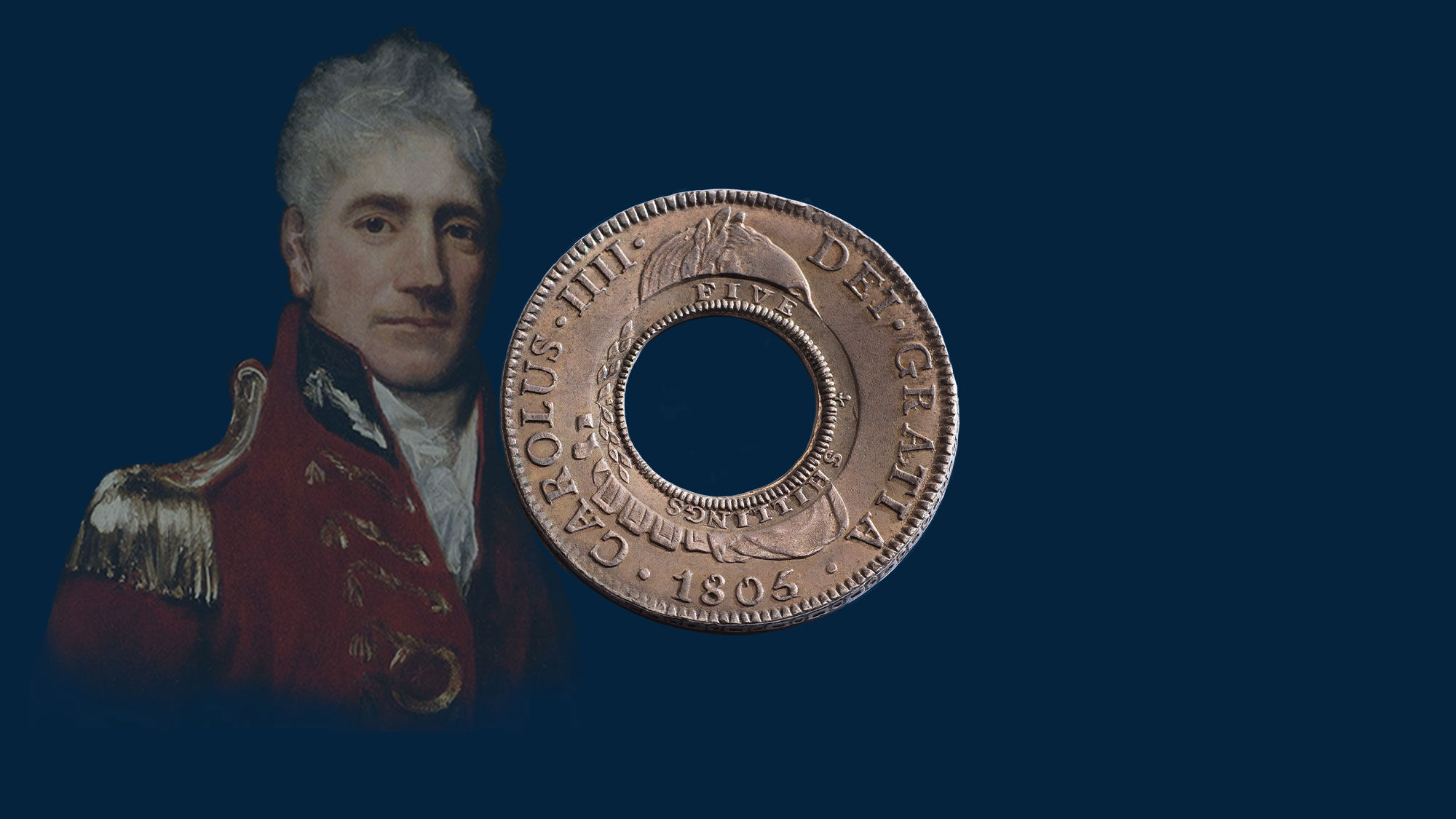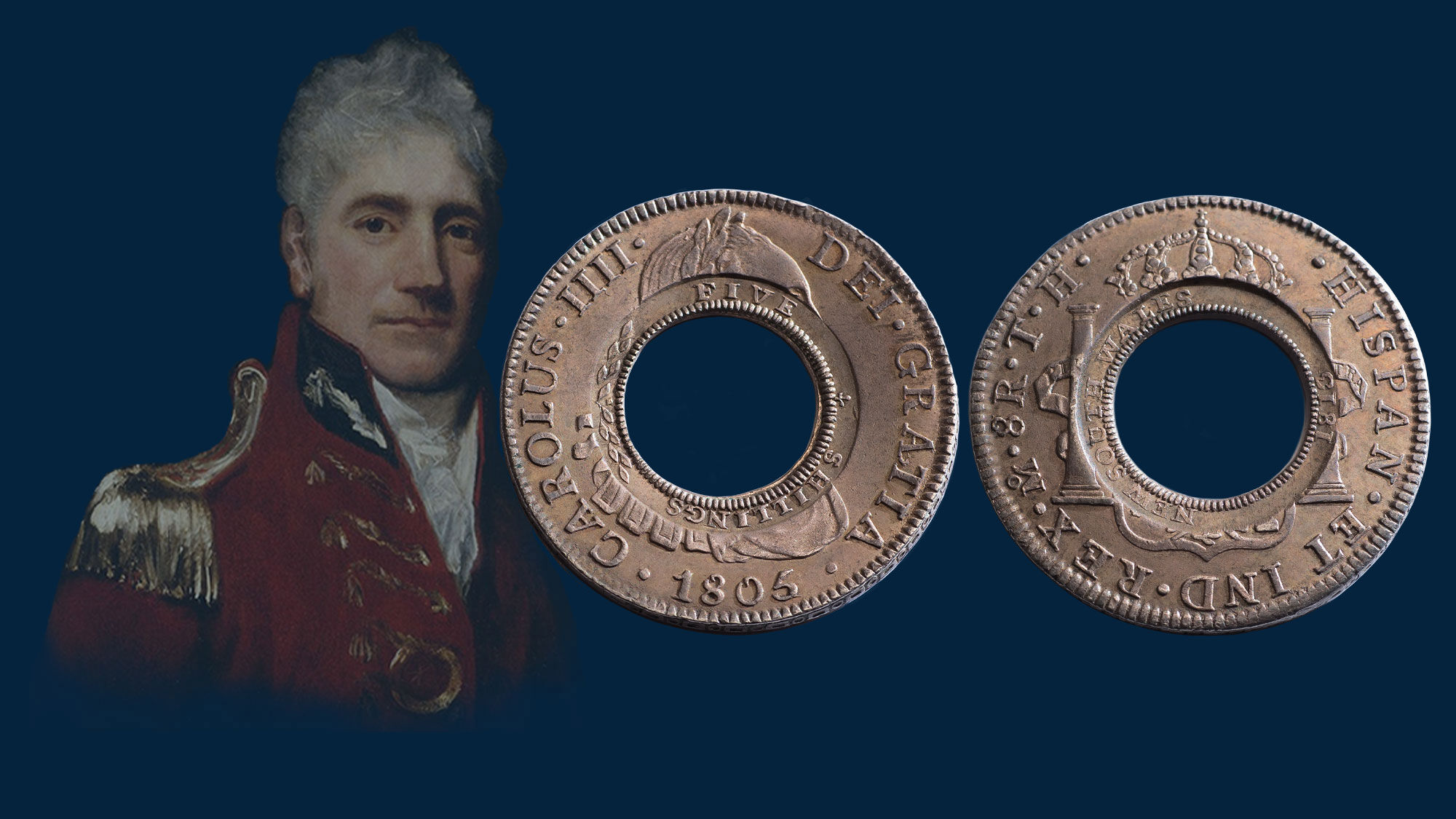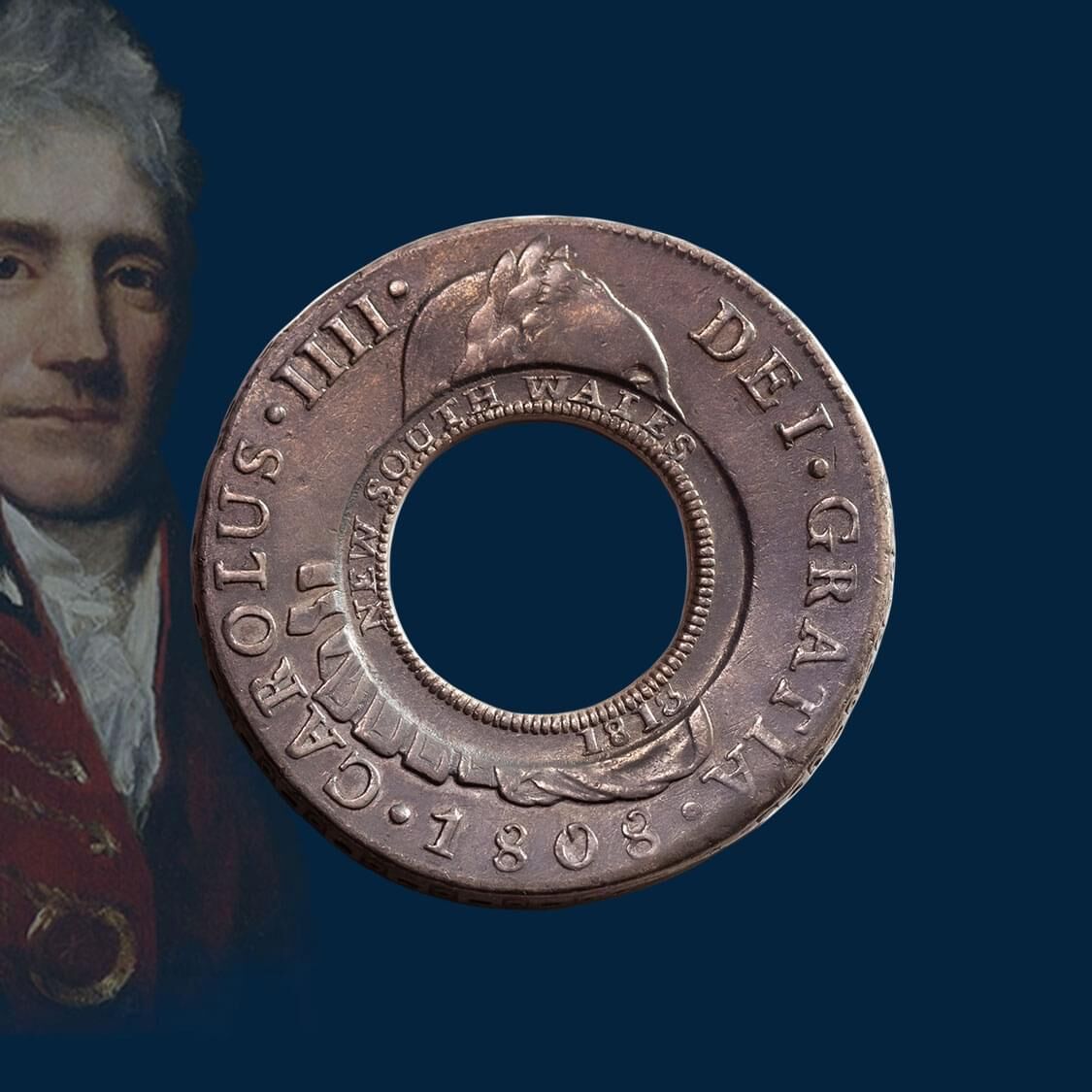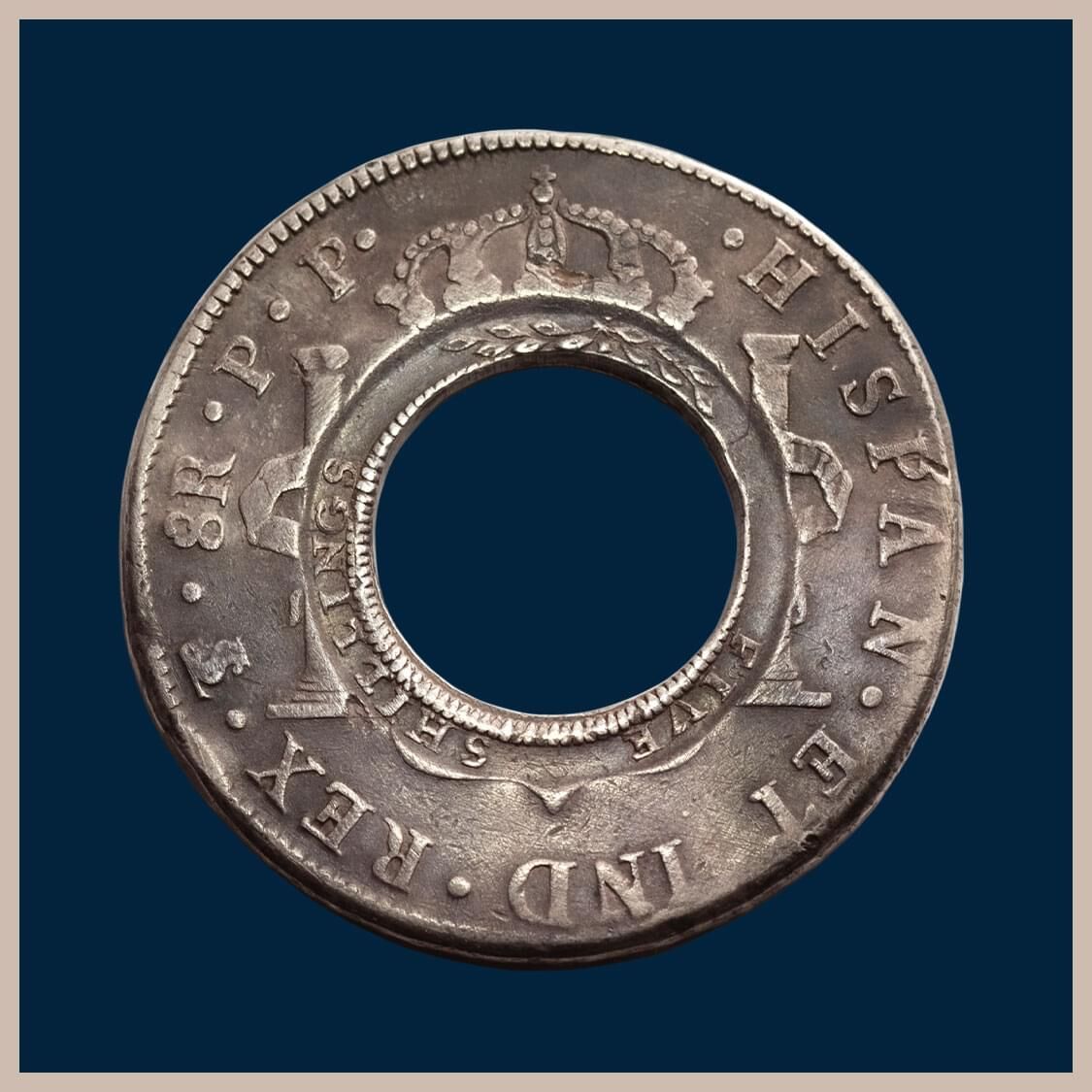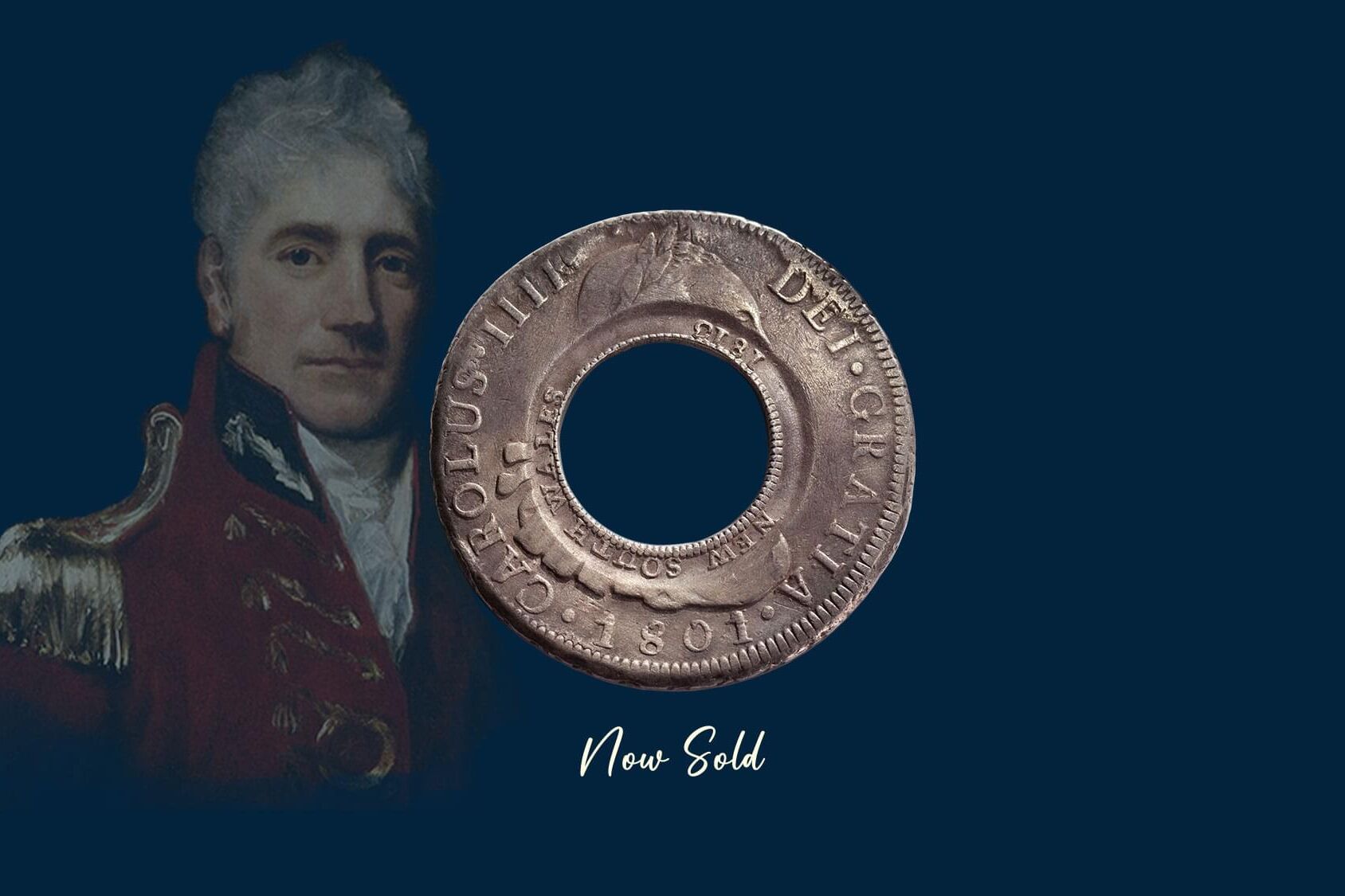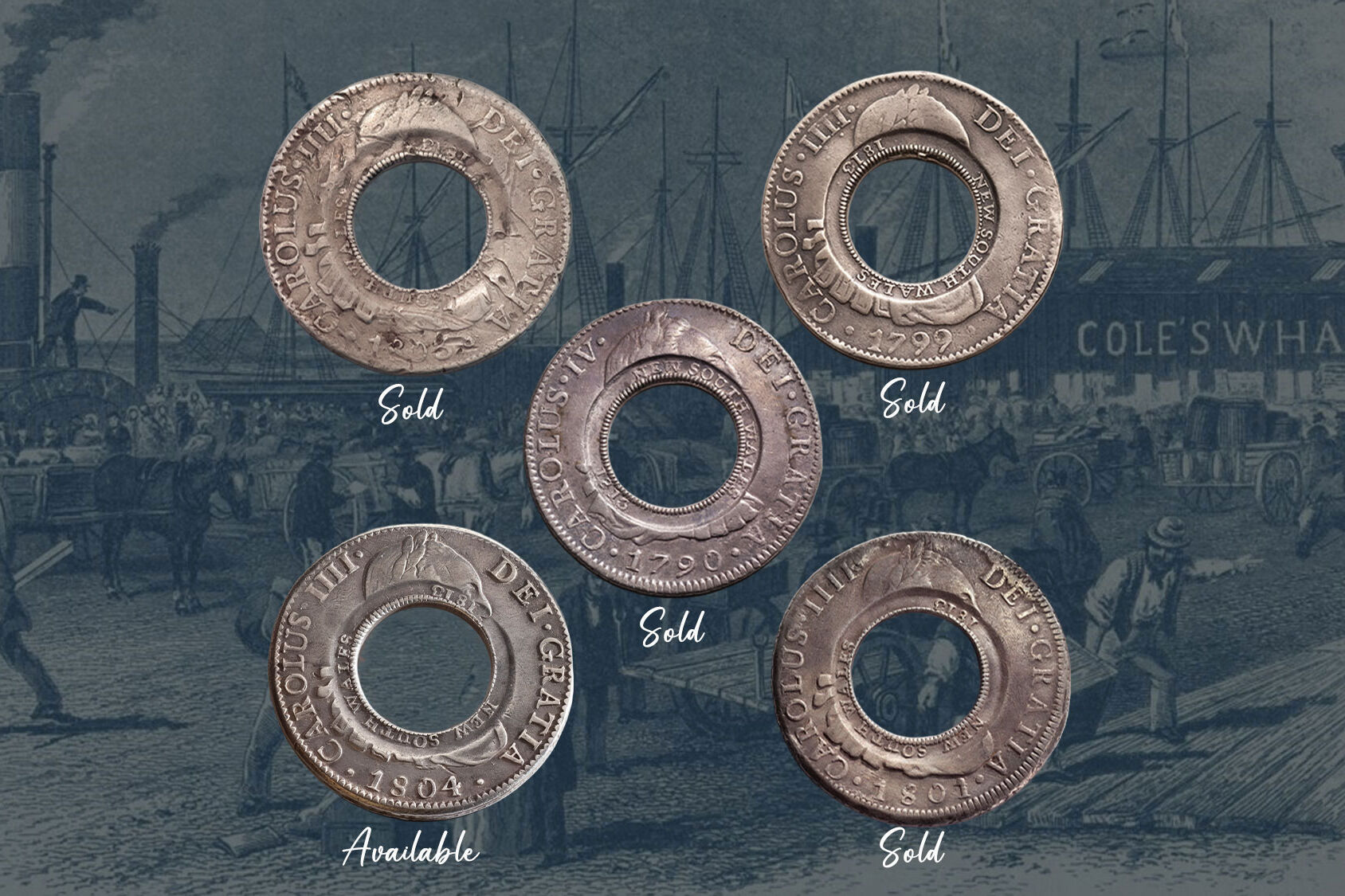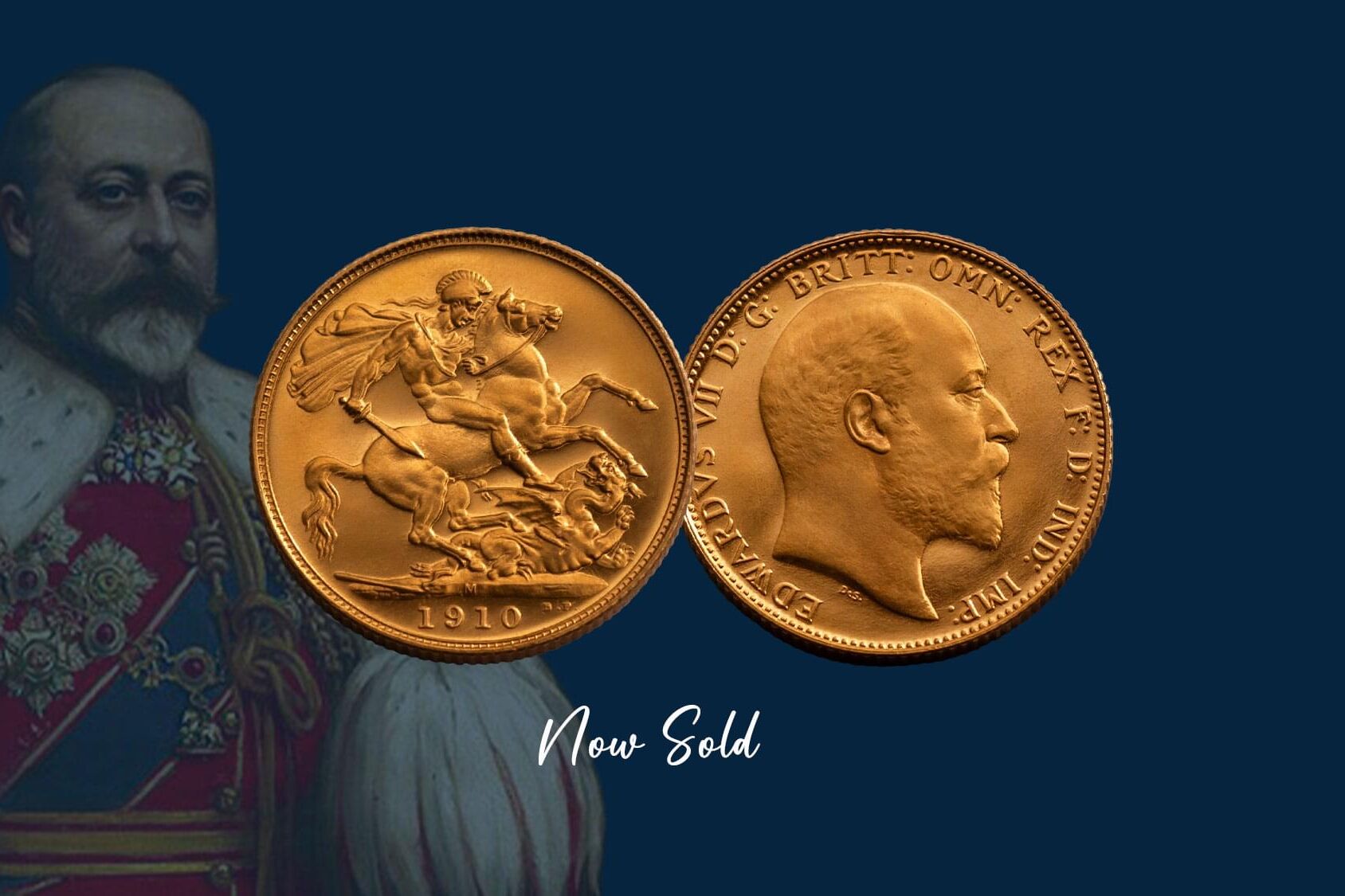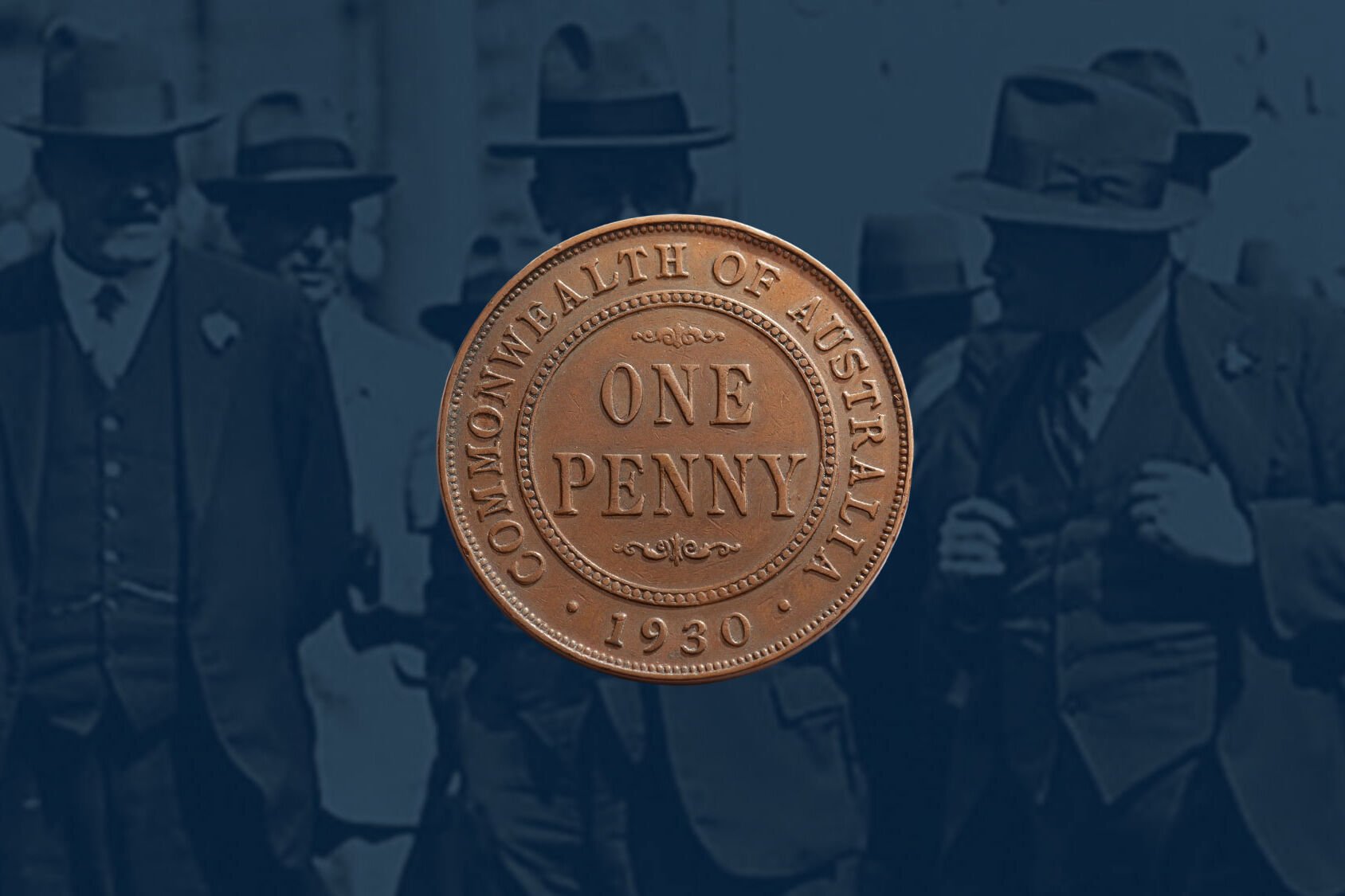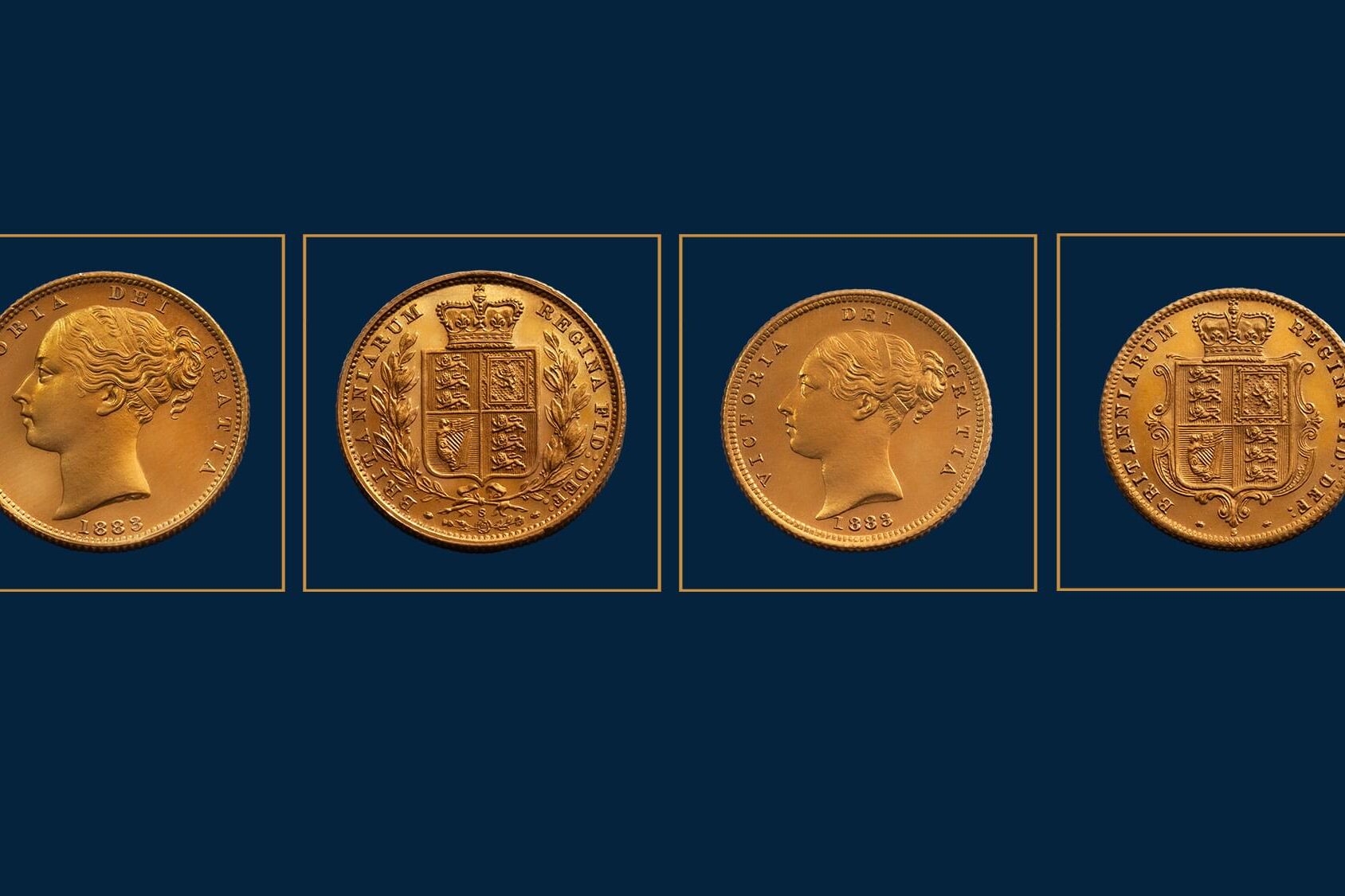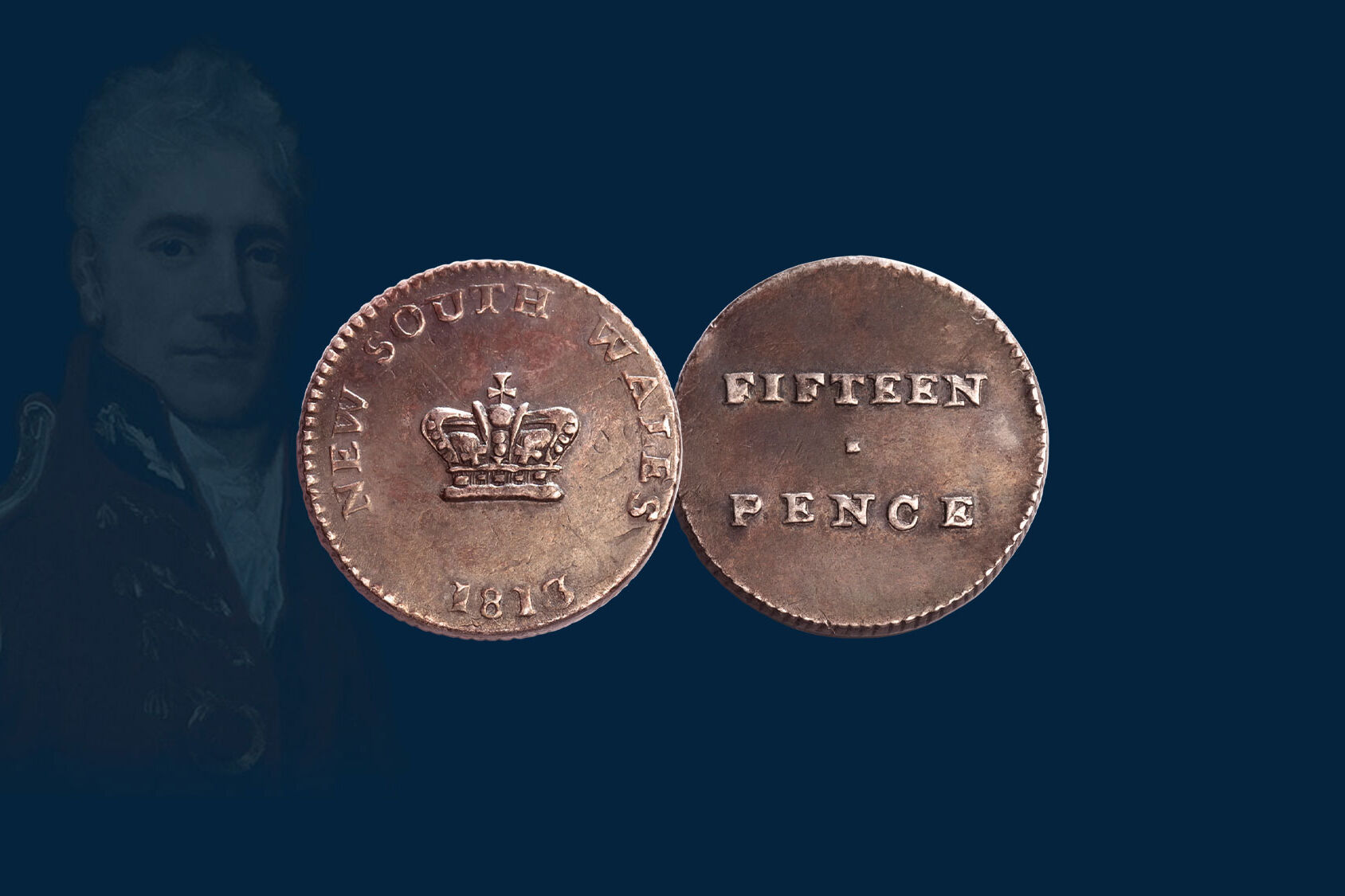The Holey Dollar is the nation’s first coin, minted in 1813 by order of Governor Lachlan Macquarie.
The Holey Dollar is the nation’s first coin, minted in 1813 by order of Governor Lachlan Macquarie.
The issuing of Australia’s first coinage symbolised the changing dynamics of the penal colony. New South Wales had started out in 1788 as a jail, a repository for convicts, under the governorship of Captain Arthur Phillip. It had emerged some twenty-five years later as a thriving economy requiring a formal medium of exchange to support a burgeoning commercial hub.
As Macquarie had no access to metal blanks to create his currency, he improvised and acquired 40,000 Spanish Silver Dollars as a substitute.
To make his new coinage unique to the colony, and to inhibit their export, he employed emancipated convict William Henshall to cut a hole in each silver dollar. Each holed silver dollar was then over-stamped on both sides, around the edge of the hole. On one side, the date 1813 and the issuing authority of New South Wales.
And on the other side, the value 'Five Shillings' with some decorative embellishments of a fleur de lis, a double twig of six leaves and a tiny 'H' for Henshall at the junction of the twigs.
The application of the counter stamps is the point at which the holed silver dollar became the 1813 Holey Dollar, the nation's first locally made coinage.
While the original intention was to create 40,000 Holey Dollars from 40,000 silver dollars, spoilage and the despatch of samples back to Great Britain saw a slightly reduced number of Holey Dollars - 39,910 - released into circulation.
Today there are approximately 200 Holey Dollars held by private collectors with perhaps 100 held in museums. The coin is a national treasure and is revered and sought after by collectors, the world over.
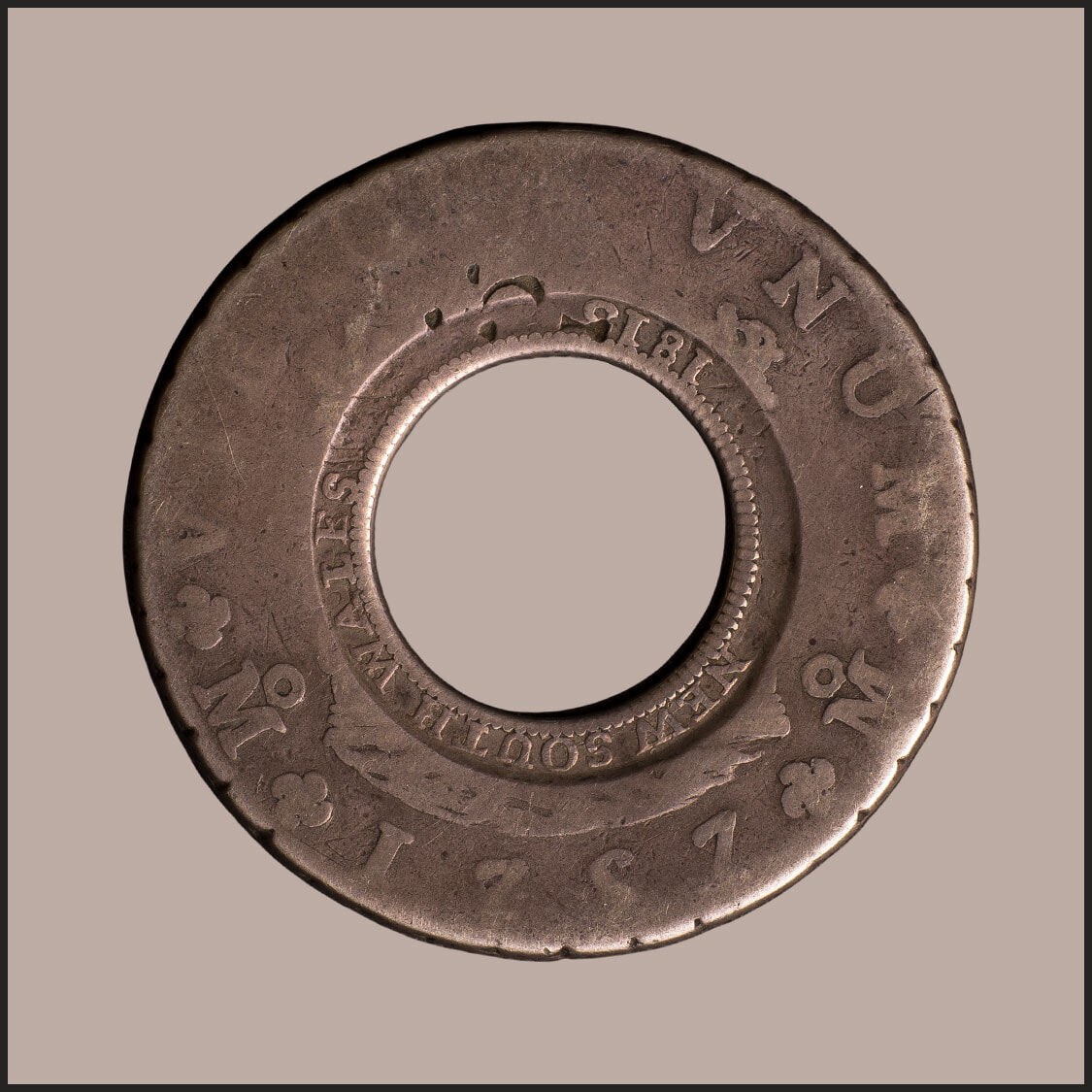
Type 1
Ferdinand VI

Type 2
Charles III

Type 3
Charles III Deceased

Type 4
Charles III on Charles IV
When you look closely at the Holey Dollars shown above, each coin has a different date and the legend and portraits, can vary. From left to right, we note the dates 1757, 1788, 1789 and 1790. And the legend of Charles III and Charles IV.
The Holey Dollar is a story. Its narrative, is as much about Australian history as it is about European history, charting the changing Spanish monarchs, Ferdinand VI, Charles III, Charles IV and Ferdinand VII. And reflecting the associated political and social turmoil that so often occurs when a monarch dies or abdicates.
As to why there are different dates and monarchs appearing on the Holey Dollars?
The simple answer is that the Holey Dollar was not created from a silver blank onto which a decorative pattern was stamped in a mass production process that produced thousands of uniformly struck coins, each featuring the same design.
The Holey Dollar was created from another coin, a Spanish Silver Dollar, and that coin came with different dates and in various levels of quality, most well used.
Forty thousand Spanish Silver Dollars were imported by Governor Lachlan Macquarie from the East India Company to convert into forty thousand Holey Dollars, the nation's first circulating currency.
The order for the dollars was not date specific, any date would suffice. Ferdinand VI reigned from 1746 to 1759. Charles III, 1759 to 1788. Charles IV was the reigning monarch from 1788 to 1808 and Ferdinand VII endured a disrupted reign, 1808 and again between 1814 and 1833.
And as each king ascended the throne, the design of the dollar was re-created with a re-styled legend and a re-styled portrait to record the new reigning monarch.
Holey Dollars are classified into types based on the legend and portrait of the monarch depicted on the original Spanish Silver Dollar.
There are eight distinct types of Holey Dollars as photographed above. And detailed here.
Type 1 - Ferdinand VI Holey Dollar
Design: features the legend and portrait of Ferdinand VI (1746 - 1759).
Availability: 2
Type 2 - Charles III Holey Dollar
Design: features the legend and portrait of Charles III (1759 - 1788).
Availability: 22
Type 3 - Charles III, deceased, Holey Dollar
Design: features the legend and portrait of the deceased King Charles III, depicted on silver dollars issued during the reign of Charles IV (1788 - 1808).
Availability: 2
Type 4 - Charles III on Charles IV Holey Dollar
Design: features the legend of the reigning monarch Charles IV and the portrait of the deceased King Charles III.
Availability: 8
Type 5 - Charles IV Holey Dollar
Design: features the legend and portrait of Charles IV (1788 - 1808)
Availability: 129
Type 6 - Charles IV Continental Holey Dollar
Design: struck from a Continental Silver Dollar, featuring the legend and portrait of Charles IV.
Availability: 1
Type 7 - Ferdinand VII Holey Dollar
Design: features the legend and portrait of Ferdinand VII. Ferdinand VII was exiled in 1808, Napoleon Bonaparte proclaiming his brother Joseph as king of Spain from 1808 to 1813.
Availability: 13
Type 8 - Hannibal Head Holey Dollar
Design: features the legend of Ferdinand VII and an imaginary portrait of the monarch referred to as the 'Hannibal Head'. Ferdinand VII was exiled in 1808, Napoleon Bonaparte proclaiming his brother Joseph as king of Spain from 1808 to 1813.
Availability: 2

Type 5
Charles IV

Type 6
Charles IV Continental

Type 7
Ferdinand VII

Type 8
Ferdinand VII Hannibal Head
Now, look closely again at the eight Holey Dollars shown above, and you will notice that the counter stamps, New South Wales, 1813 and Five Shillings applied discretely around the edge of the hole are not uniformly positioned. And there is no consistency as to which side of the coin they appear on.
As to why the counter stamps are in different positions and on different sides of the coin?
The counter stamps are important as technically the application of the counter stamps, New South Wales, 1813, and Five Shillings was the point at which the holed Spanish coin became the 1813 Holey Dollar, the nation's first locally made coinage.
A study of the surviving Holey Dollars reveals that Henshall's application of the counter stamps was wildly random, that the holed dollar was not placed in a particular position between the dies.
And it obviously didn't matter which side of the holed dollar was facing up.
The process used a simple drop hammer system and speed was of the essence. Precision was simply not required which is why the counter-stamps of most Holey Dollars are 'all over the shop'.
The extent of wear on the counter stamps indicates the degree of circulation of the Holey Dollar.
It is noted that the Holey Dollar, as a high denomination coinage (Five Shillings) was stored by the Bank of New South Wales, as backup for their banknotes. Thereby minimising the wear of the counter stamps on most Holey Dollars.
Why Collectors Acquire the Holey Dollar
In the realm of rare coins, Holey Dollars exist on a different plane. They transcend mere collectibles and have become coveted objects that represent the pinnacle of Australia's numismatic industry, our very first coin.
Owning a Holey Dollar isn't just about adding another coin to a collection.
It's about indulging in an experience, a fusion of history and prestige and we hope the information provided above, triggers your interest.
Remember, you are not just buying a coin, you own the experience. So enjoy it!
Final points to consider when acquiring a Holey Dollar
Setting a budget
A budget is the first step in the task of acquiring a Holey Dollar knowing that at whatever level you spend, the Holey Dollar, as the nation's first coin, never goes out of fashion. And will always be in demand.
As a guide, let's look at the more readily available Type 5 Holey Dollar, featuring the legend and portrait of Charles IV. As the most readily available, it is therefore the most affordable.
A starting price for a well circulated Type 5 Mexico Mint Holey Dollar is approximately $50,000. Prices move up from here, depending on the quality, the mint and the design type of the Holey Dollar.
Be prepared to wait
There are less than two hundred Holey Dollars available to collectors. Compare it to the 1930 Penny, where fifteen hundred are believed to exist. So, if the 1930 Penny is rare, the Holey Dollar is 'super-rare'.
Our estimate is that one or two Holey Dollars may come onto the market annually.
Note that you could be waiting at least twenty years for the rarest types to come onto the market, Type 1 where there are two known, Type 3 (also two known), Type 6 (unique) and Type 8 (again, two known). Working against the buyer is the fact that Holey Dollars tend to be held for the long term, viewed as family heirlooms.
Some mints are rarer than others
Governor Lachlan Macquarie placed his order for the Spanish Silver dollars with the East India Company, the coins originating from various mints around the world.
The percentage of Holey Dollars converted from the mints in Mexico, Lima, Potosi and Madrid are noted below.
• Holey Dollars converted from Mexico Mint dollars - 81 per cent
• Holey Dollars converted from Lima Mint dollars - 10 per cent
• Holey Dollars converted from Potosi Mint dollars - 8 per cent.
• Holey Dollars converted from Madrid Mint dollars - 1 per cent
Quality and price go hand-in-hand
Macquarie did not set any quality parameters on his shipment of 40,000 coins. He wanted quantity. Not quality! That, and the fact that, the Spanish Silver Dollar was an internationally traded coin means that most Holey Dollars are today found well worn. The chart below indicates the percentage available to collectors at the various quality levels.
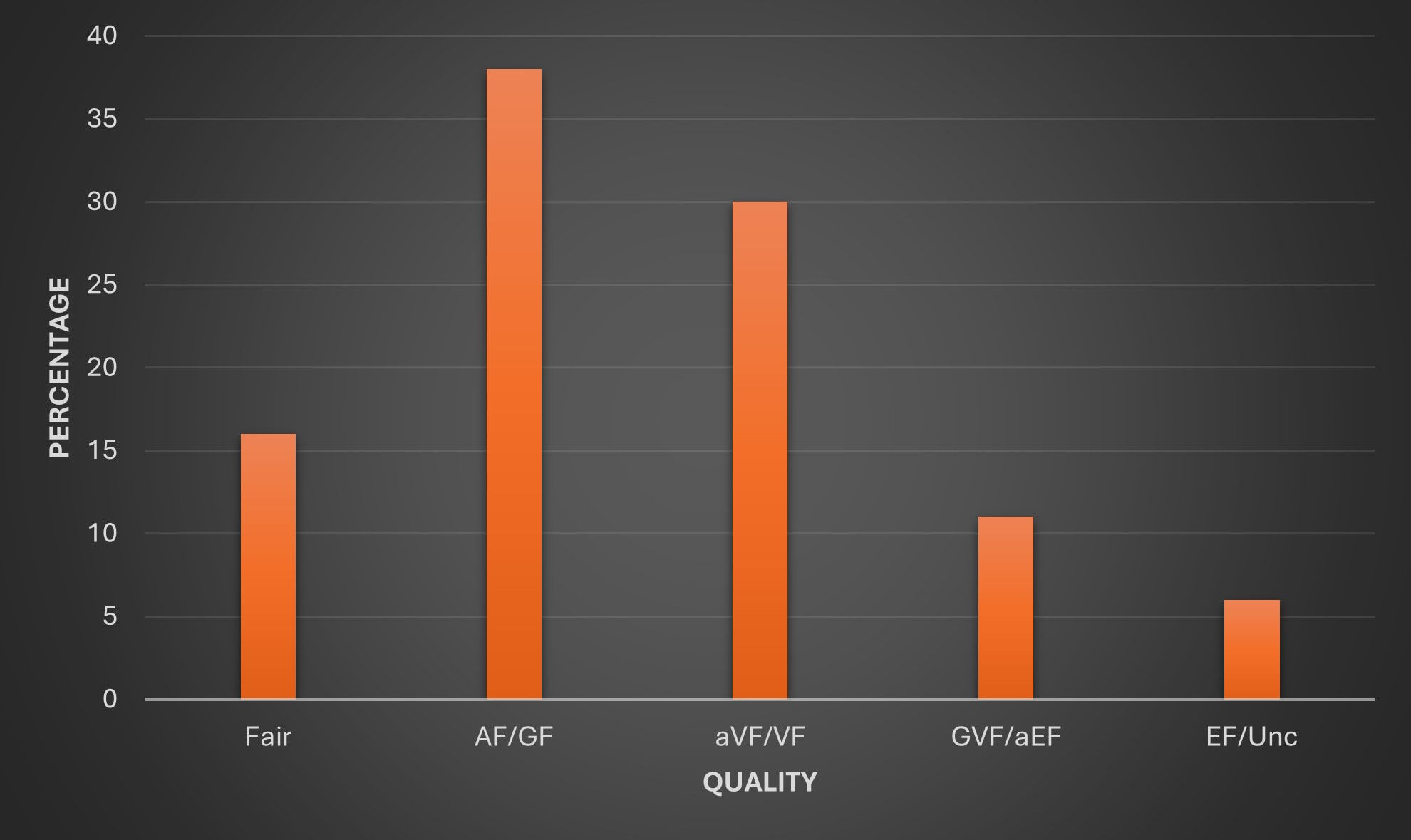
Fair to Good
Heavily circulated and akin to a washer.
About Fine to Good Fine
Extensive circulation, the general design recognisable but the significant parts of the design have worn away. Knocks in the fields will be visible.
About Very Fine to Very Fine
Circulated with some elements of the design, the detail in the hair and detail in the robes, worn down.
Good Very Fine to About Extremely Fine
Circulated with design details slightly worn.
Extremely Fine to Uncirculated
Well preserved with the slightest hint of wear. Obviously, no wear in the uncirculated example, of which there is only one.
A final consideration of the counter stamps
With respect to Holey Dollars, the last item on your check list is to consider the counter stamps in the knowledge that the circulation of the Holey Dollar is reflected in the wear to the counter stamps. Some Holey Dollars do show a precise alignment of the counter stamps and these pieces are highly valued.
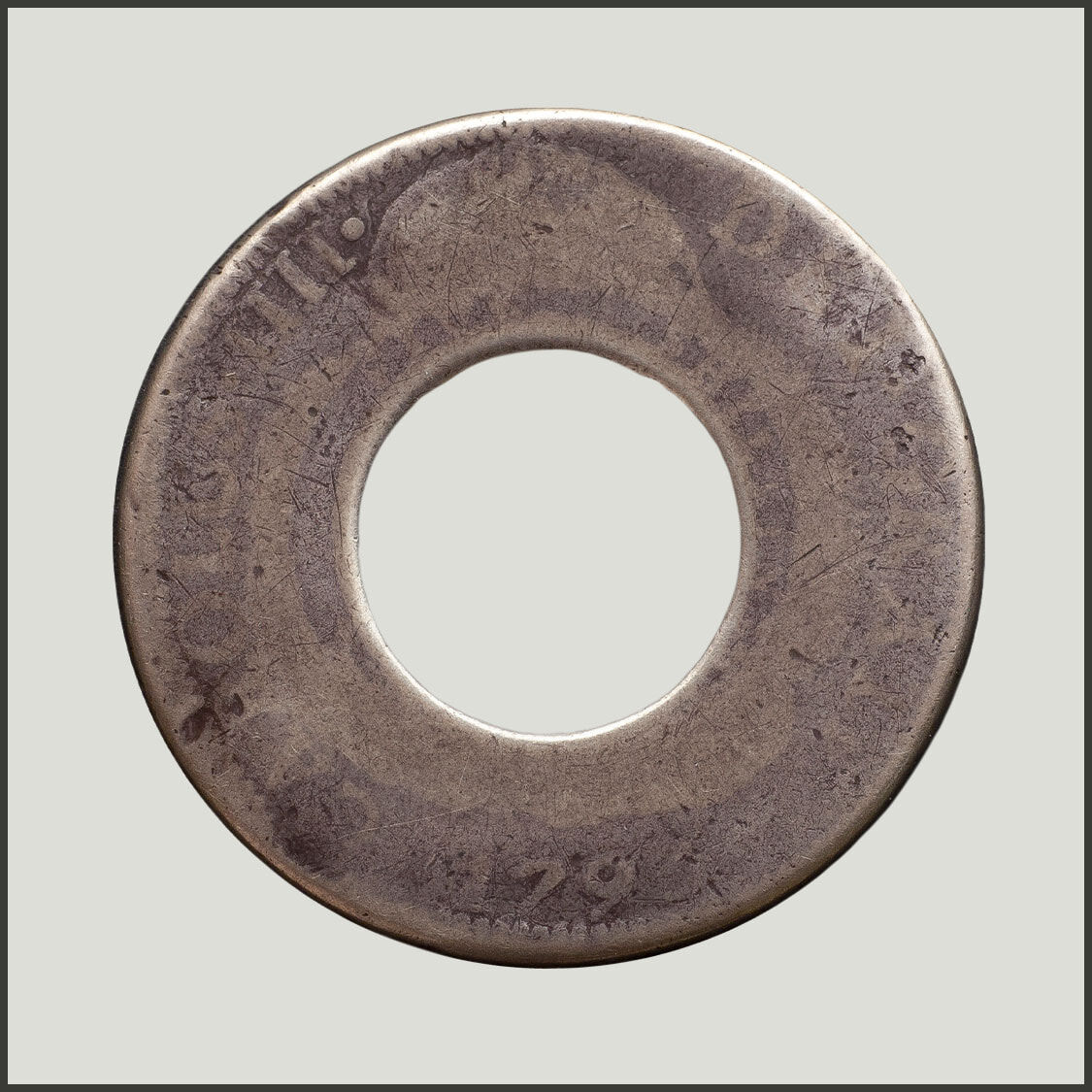
Quality
Fair to Good

Quality
Fine
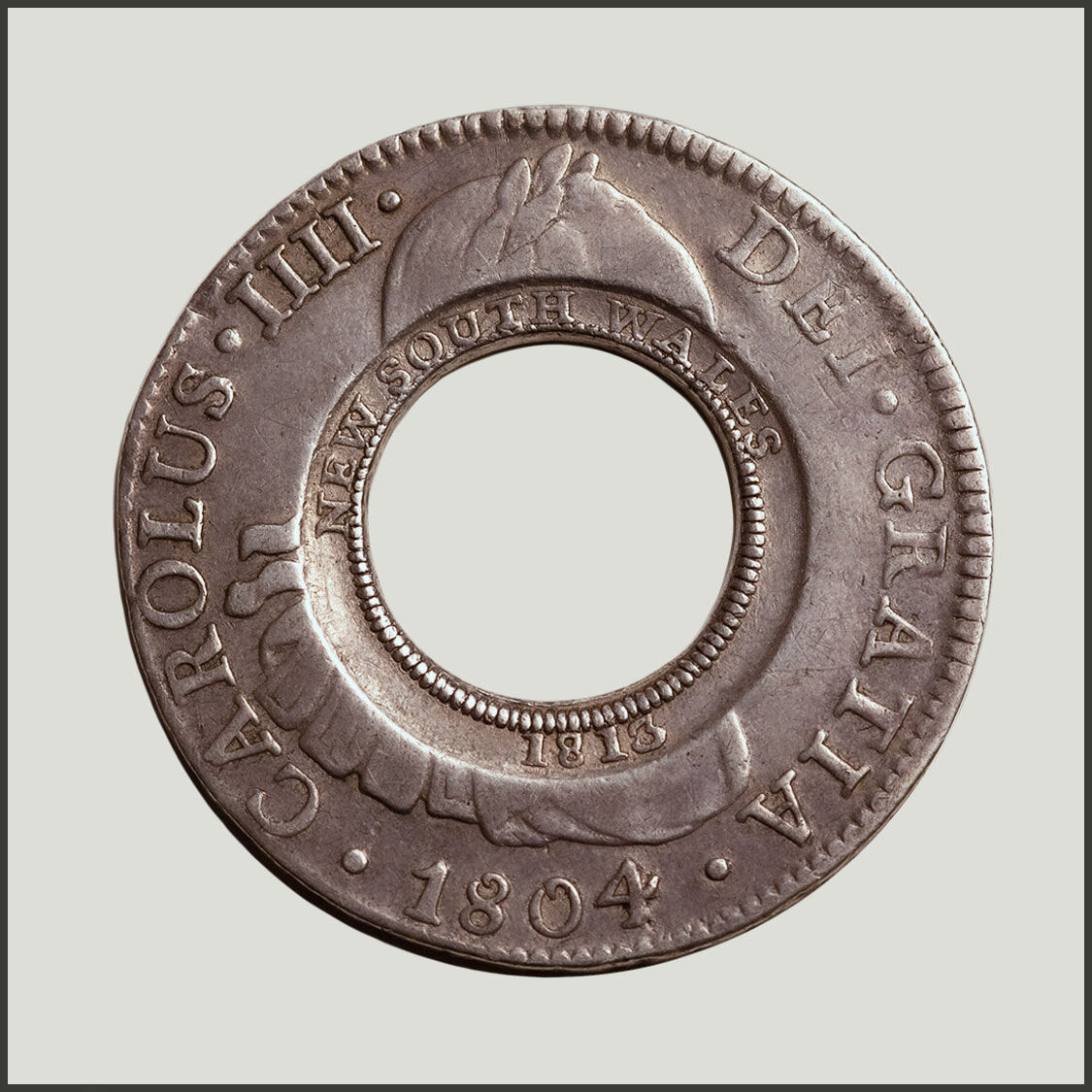
Quality
Very Fine
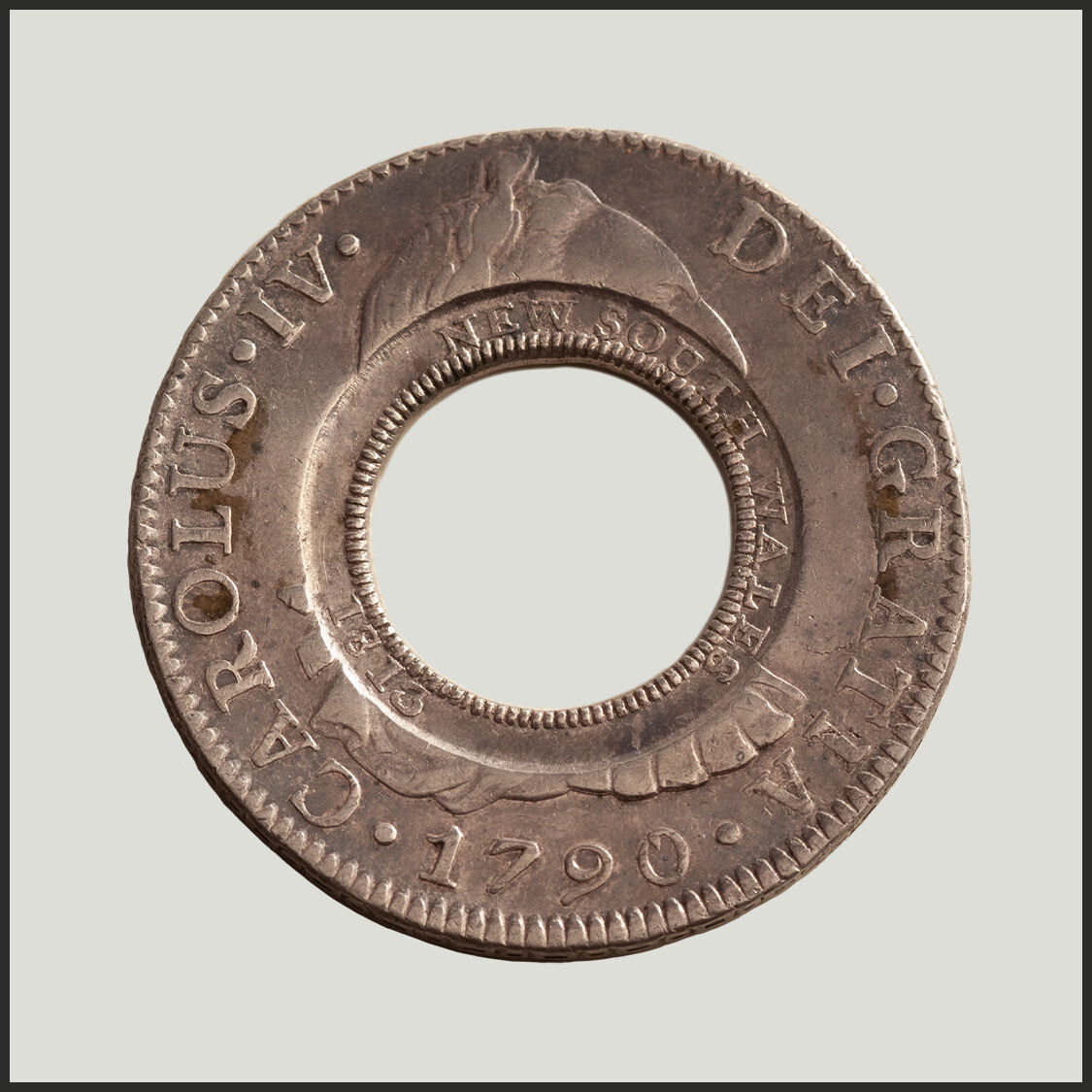
Quality
Nearly Extremely Fine
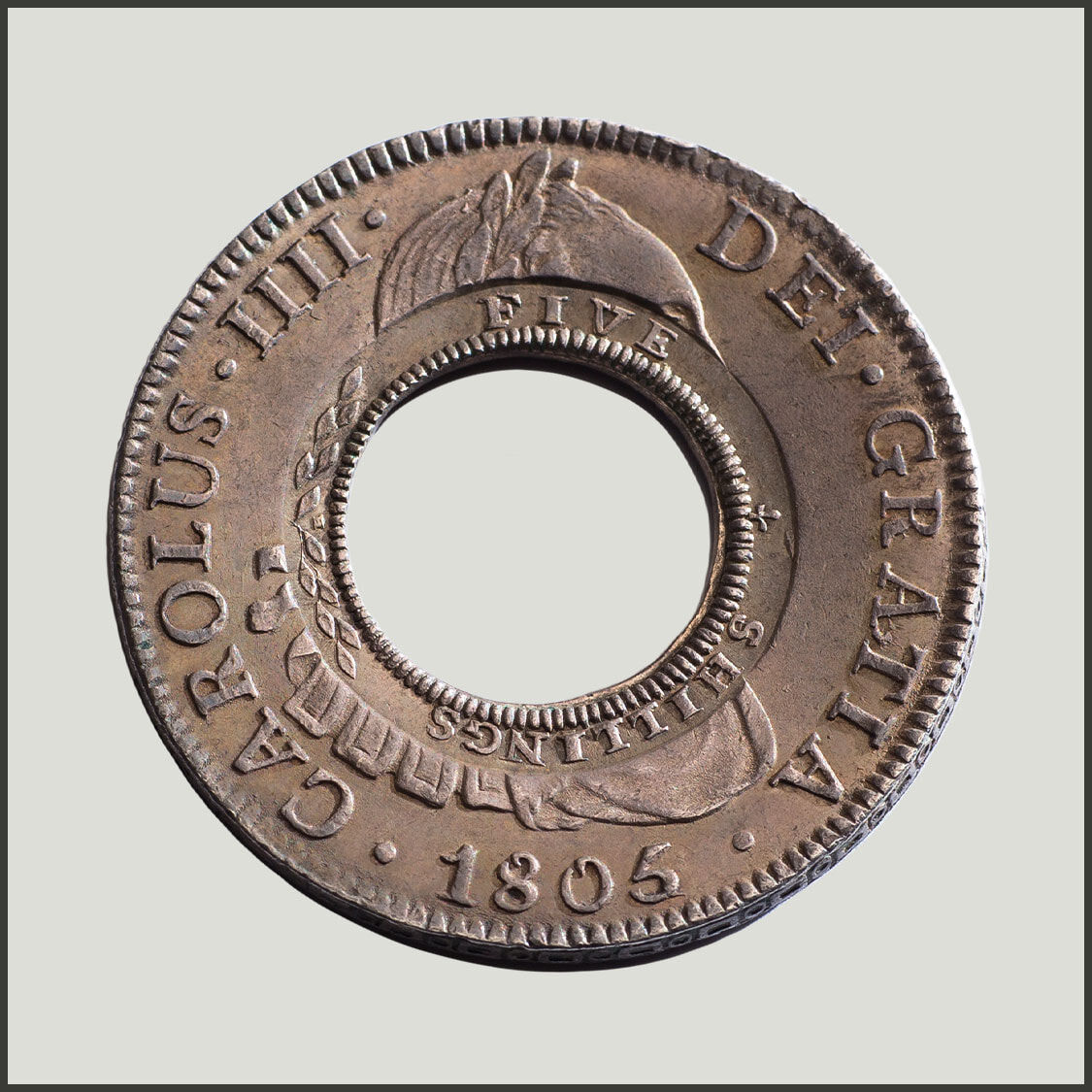
Quality
Uncirculated
The History of the Holey Dollar
Our first coins and our first mint master
The British Government had no capacity to supply Governor Lachlan Macquarie with metal blanks to create Australia’s first coinage so, he improvised and ordered 40,000 Spanish Silver Dollars - foreign coinage - to use as his substitute for blanks.
Concluding that the shipment of 40,000 Spanish Silver Dollars would not suffice, Macquarie decided to cut a hole in the centre of each dollar, thereby creating two coins out of one, a ring dollar and a disc.
While some history buffs may laud Macquarie for his brilliance in creating the nation's first coin from another coin ... it was an extension of a practice of ‘cutting’ coins into segments, widely used throughout the British colonies of the Caribbean and several African nation’s including Sierra Leone.
Macquarie needed a skilled coiner to carry out his project and he appointed an emancipated convict, William Henshall to the task. Henshall had been apprehended in 1805 for forgery, counterfeiting Bank of England Dollars, and sentenced for seven years in the penal colony of New South Wales.
Henshall, acquired his skills as an engraver in Birmingham, where the major portion of his apprenticeship consisted of mastering the art of die sinking and die stamping for the shoe buckle and engraved button trades. Perfect qualifications for the role of Australia's first Mint Master!
A crude process but it worked ...
Enlisted by Lachlan Macquarie as the colony’s first Mint Master, Henshall commenced the coining process by cutting out a disc from each silver dollar.
The donut shaped silver piece, with the hole in the middle, was over stamped around the edge of the hole with the date 1813 and New South Wales and became the Holey Dollar with a monetary value of five shillings.
The small disc that fell out of the centre of the silver dollar was not wasted but was over stamped with the date 1813, New South Wales and a crown and became the Dump. Its monetary value was fifteen pence.
The origin of the names - Holey Dollar and Dump
The holed coins were officially known as ring, pierced or colonial dollars and although ‘holey’ was undoubtedly applied to them from the outset, the actual term ‘holey’ dollar did not appear in print until the 1820s.
The term ‘Dump’ was applied officially right from the outset and is a name that continues to this day.
The shipment of 40,000 Spanish Silver Dollars was converted into 39,910 Holey Dollars and 39,910 Dumps. Spoilage, mishaps during the minting process, and specimens sent to Great Britain as an official record of the strike account for the balance of the coins.
In creating two coins out of one, Macquarie effectively doubled the money supply. And increased the total worth of the shipment of 40,000 coins by 25 per cent.
Recall of Australia's first coins
The Holey Dollar and Dump remained as currency within the colony until 1829. The colony had by then reverted to a sterling standard and a general order was issued by Governor Darling to withdraw and demonetise the nation's first coins. The recalled specie were eventually shipped off to the Royal Mint London, melted down and sold off to the Bank of England for £5044.
FAQs - The 1813 Holey Dollar
I have a Holey Dollar. I would like to know what it is worth.
First up, take photographs of both sides of the coin.Email them to info@coinworks.com.au for an initial assessment and valuation.
I am confused. The coin is always referred to as the 1813 Holey Dollar, but I cannot see the date 1813. I only see another date. An earlier date.
Australia’s first coin, the Holey Dollar was created from a Spanish Silver Dollar. And the date you see is the year in which that original Spanish Dollar was created.
History tells us that Governor Lachlan Macquarie ordered 40,000 Spanish Silver Dollars to convert into Australia’s first local currency. Macquarie’s order was not date specific so any date would do.
He then enlisted the services of a convicted forger to cut a hole in each silver dollar, thereby creating two coins out of one.
The first coin was shaped like a donut, the second a small inner circular disc that fell out of the centre of the donut.
The donut was over stamped with the date 1813 and the value and became the Holey Dollar, the stamping occurring around the inner circular edge of the hole.
The 1813 is discrete but look closely and it is visible.
Can I sell my Holey Dollar through Coinworks?
Absolutely.
Coinworks can offer you two options here. We can purchase the coin outright. Or sell the coin on your behalf on a consignment basis at a fixed commission rate.
Either way we will have to physically sight the coin. And we will require background information as to where it was obtained.
Please Contact us for more details.
Should I clean my Holey Dollar to make it look brand new?
Rule of thumb. Do not touch your coins! Cleaning can impact very heavily on the potential value of any coin.
Coins are best left in their original unaltered state.
My Holey Dollar is worn. Does a worn Holey Dollar have any value?
Yes. Even a well-worn 1813 Holey Dollar has value, upwards of $50,000.
Contact us for more information.
I want to buy a Holey Dollar. What advice can you give me?
The first decision for Holey Dollar buyers is to set your budget. Holey Dollars start from about $50,000 and can move up to $400,000-plus.
Once you have set your budget you can consider the options that are available to Holey Dollar buyers.
Macquarie’s order for 40,000 Spanish Silver Dollars did not specify dates. Any date would do. It did not specify quality. Nor did Macquarie care at which mint it was produced.
Spain had colonised South and Central America and built mints in Mexico, Peru, Bolivia and Guatemala.
Holey Dollars come with variations in the date, the quality and the mint with some combinations far rarer than others. And hence more valuable.
I am considering buying a Holey Dollar. Should I wait for an Uncirculated one?
The majority of Holey Dollars come well-worn and the reason is simply that the coin from which they were created, the Spanish Silver Dollar, was at the time the world’s greatest trading coin.
So, the majority of dollars imported by Macquarie would have been well worn.
There is an Uncirculated 1813 Holey Dollar and that particular example resides with a Coinworks client. It is in every respect a miracle coin and we do not expect to see it back on the market for several decades, if ever.
Contact us for more information.
How many Holey Dollars were struck and how many survive today?
Although 40,000 Spanish Silver Dollars were imported and converted into Holey Dollars, 90 were spoiled during production. The balance of 39,910 were released to be used.
The Holey Dollar was withdrawn and demonetised in 1829, with many shipped off to London and melted down.
Today there are approximately 200 Holey Dollars held by private collectors with perhaps 100 held in museums.
The figure ‘200’ is the critical one for collectors.
Highlights of Coinworks Inventory
© Copyright: Coinworks
